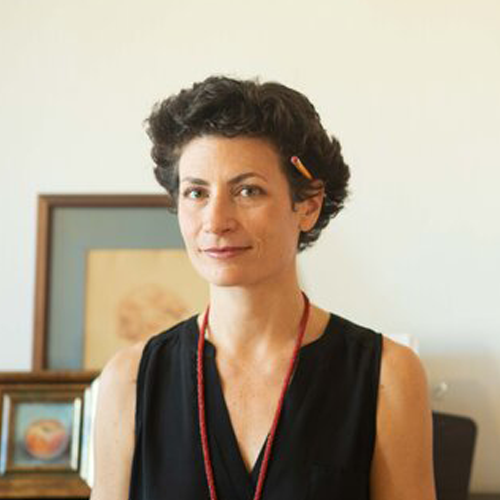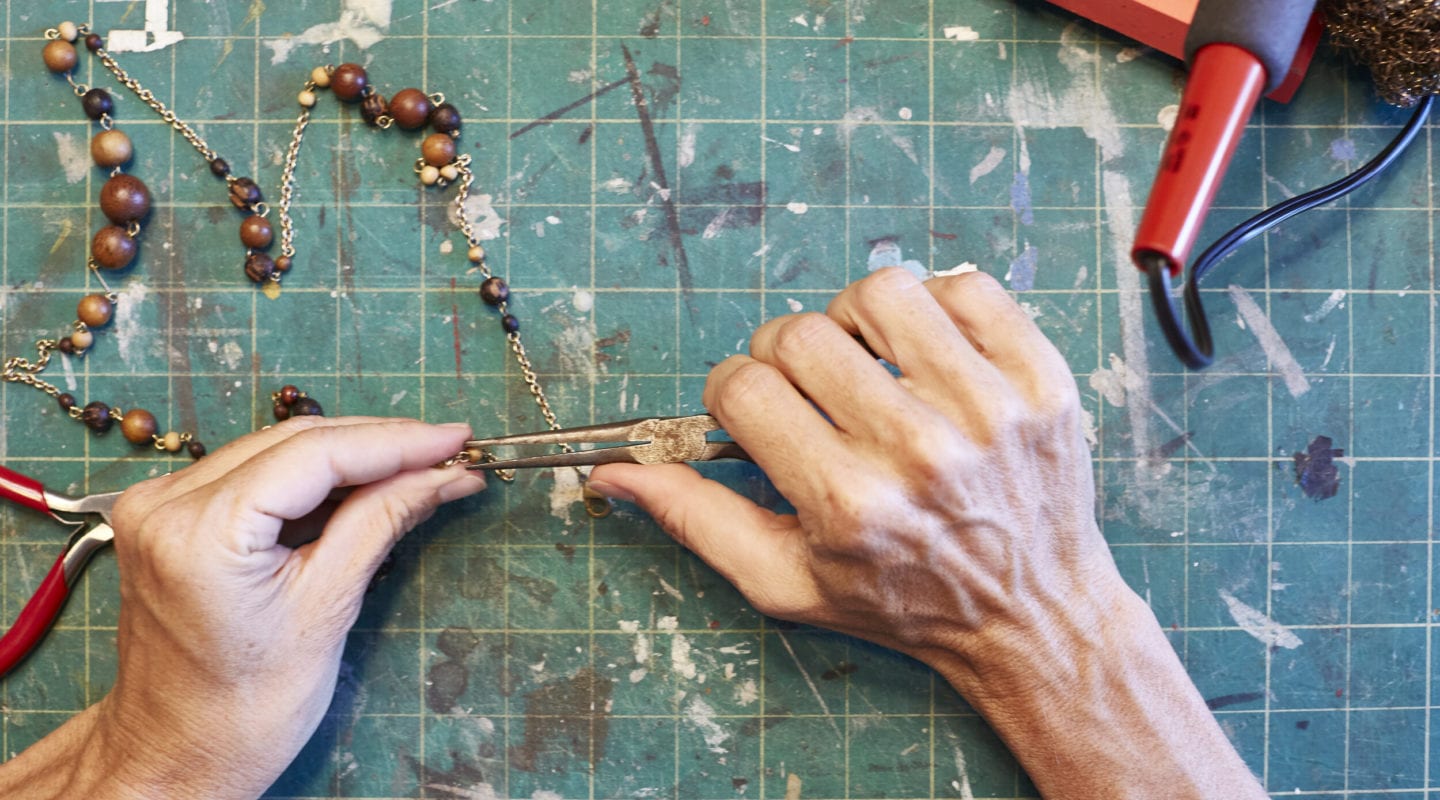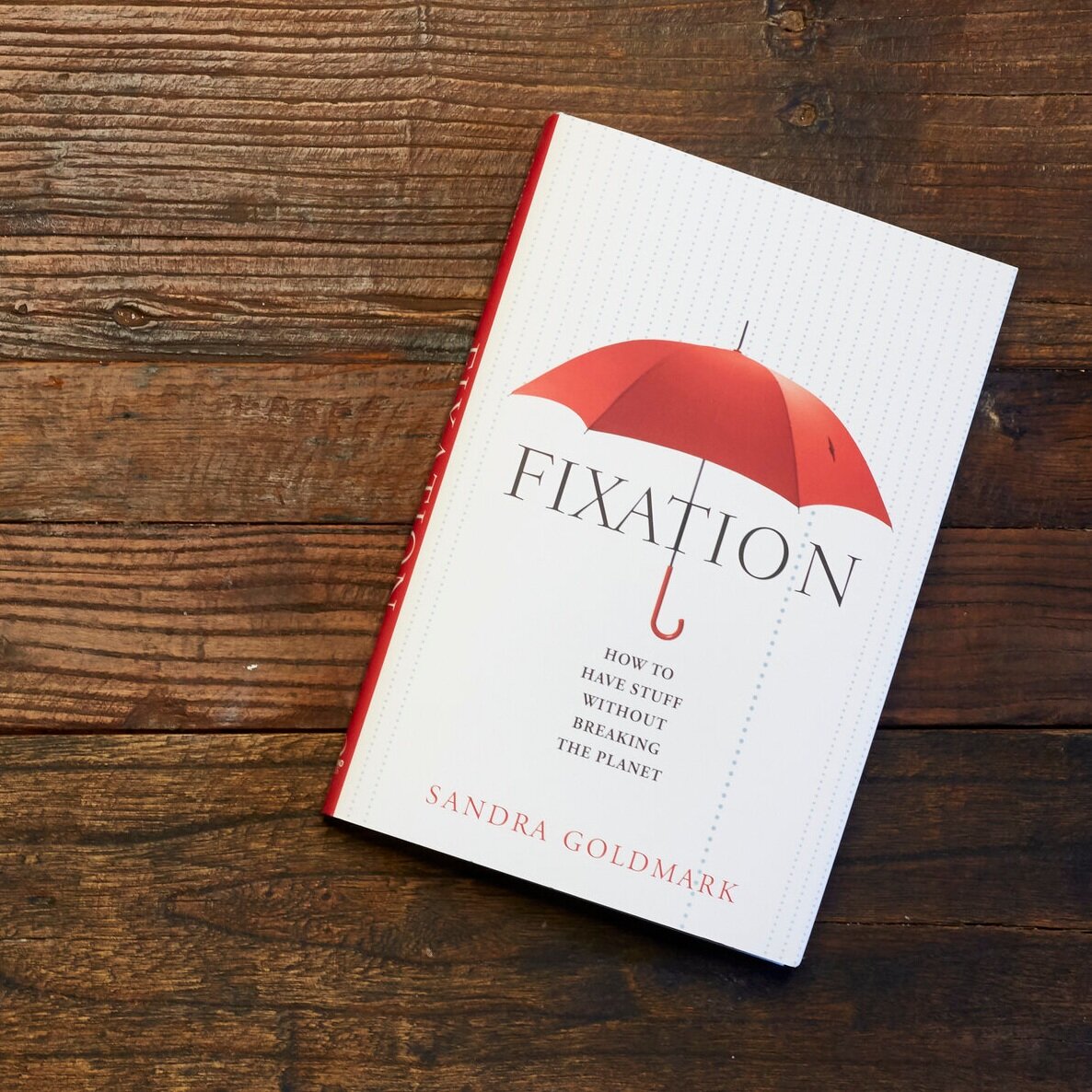Question: What do a stuffed lobster, a chi revitalizer, and set design have in common? Answer: Sandra Goldmark’s new book, Fixation: How to Have Stuff without Breaking the Planet, which is due out this Tuesday, September 22. From lamps and chairs to, yes, stuffed lobsters and backstage magic, Fixation uses a series of objects repaired by theatre artisans in Sandra’s pop up repair shops to examine our relationship with “stuff” and chart a clear path to a more sustainable, equitable, and circular economy.
 Sandra Goldmark is a designer, teacher, and entrepreneur whose work focuses on circular economy solutions to overconsumption and climate change. She is an Associate Professor of Professional Practice and Director of Sustainability and Climate Action at Barnard College. Sandra is a co-creator of the Sustainable Production Toolkit, and has collaborated with HVSF as a scenic designer and consultant on our 2017 and 2018 seasons.
Sandra Goldmark is a designer, teacher, and entrepreneur whose work focuses on circular economy solutions to overconsumption and climate change. She is an Associate Professor of Professional Practice and Director of Sustainability and Climate Action at Barnard College. Sandra is a co-creator of the Sustainable Production Toolkit, and has collaborated with HVSF as a scenic designer and consultant on our 2017 and 2018 seasons.
The gifted property of HVSF’s new, permanent home was purchased by our generous donor, Chris Davis, in 1999 to save it from development. Our new home has spectacular views of Storm King Mountain, a site that played an important role in the birth of the contemporary American environmental movement. We are viewing this gift as a mandate to become even more environmentally conscious and as an opportunity to adopt sustainability as a new core value for HVSF. We were fortunate enough to grab some time from Sandra to talk about sustainable design and production practices in the theater.
Can you tell us about how you became interested in and started working in theater?
I started working in theater in high school – painting backdrops for our productions of South Pacific, Grease, and of course Sing!, the high-drama student-written musical competition where soph-frosh, juniors, and seniors battle for glory through song and dance. It was hilarious, and weirdly formative. I liked the fun, I liked the community, and I liked being backstage and making things. Then, after college, I had a job doing marketing and really felt lost – I didn’t understand what we were making or why. So I found my way back to design, working as an assistant and doing little shows downtown. Finally I went to grad school and started working professionally, and teaching.
And how did you become interested in sustainability? And when/how did you realize these two passions were interrelated?
At some point about ten years ago, I realized that I was personally responsible for thousands and thousands of pounds of waste. There I was at home, rinsing my yogurt cups and bringing my little canvas bag to the supermarket, while at work I filled dumpster after dumpster, show after show, with trashed scenery. The cognitive dissonance caught up to me, and I seriously considered quitting. Or becoming a playwright or a director, so I could have more agency – maybe I could write plays about recycling, or something? But that sounded like a terrible idea, and I didn’t want to direct or write plays. I love design, I love making stuff, I love problem solving with other people. But I couldn’t figure out how to square the waste, the heedless consumption of all the shows I was doing, with my values. So I started designing shows using only “found objects,” i.e., trash. Then I started telling people about it, and trying to convince others that this was worth doing. Then I decided to open a repair shop (this was a bit of a curve ball, but bear with me). Basically, I started really thinking about what we make, how we make it, and why. How do we create worlds – meaning – with our stuff, onstage and off? And what are we really saying if we are willing to use toxic materials, degrade our environment, and chuck it all after the show?
In theater, we buy, build, and alter a lot of “stuff” to create worlds. How do you envision theater changing if producers and designers are part of larger conversations about materials, responsibilities, and sustainability — how will this influence the design process? How have you seen it influence the process at Barnard?
In theatre, we have an incredible wealth of talent, and a lot to contribute to the larger conversation about climate change and consumption…This is one of the main themes in Fixation – that the work we do with our hands, in our community, has deep value. At the same time, we very urgently need to rethink the way we design and produce for the stage, so that what we are saying aligns with how we make it. We can’t credibly call for social change and equity, when our practices are too often wasteful, toxic, or disregard our shared resources.
On a superficial level, when we begin to seriously consider sustainability during the design process, we might encounter some changes. We begin to break down patterns – for example, the design process might extend more fully onto the shop floor, expanding the collaboration and inviting a more inclusive process. Sustainability might influence the materials we choose, or might lead us to find common design threads across multiple shows in one season. But on a deeper level, really considering sustainability can open up some big questions about what we want to do as artists, and what it really costs. Is it worth it to put a garment on stage that was stitched in appalling conditions overseas? Is it worth it to rip down virgin forests for a piece of lauan? Can we credibly work towards an anti-racist theatre but turn a blind eye towards climate change, knowing full well that the impacts of climate change are felt disproportionately by communities of color? It’s about connecting the dots, and really aligning the way we work with our values.
Can you tell us about the baseline you established at Barnard’s theater department? And what steps other theater companies (and HVSF in particular) can take to establish their own guidelines to implement sustainable theater practices?
The “circular design and production” practices we’ve been working on at Barnard are the same ideas that shape Fixation. In the book, I talk about how “stuff is just like food,” and I take a page from Michael Pollan’s food wisdom to lay out a few simple guidelines: Have good stuff, not too much, mostly reclaimed. Care for it, pass it on. These steps are the foundation for thinking about stuff for your home, or for your theatre. It’s about realizing that the impact of the materials we choose and the production practices we follow is significant – but that it is possible to change one’s practices. This is especially true for theatre, which has a very strong, and ancient, tradition of circularity, of reuse, of repair, of craft. So as theatre makers, we have a leg up – it’s not about reinventing the wheel, but really committing to – and that means budgeting for, and contractually mandating – the simple steps of a circular system.
I love this quotation from an article you wrote for Theatre Design and Technology — “In the household, or in the theater, our patterns of consumption are a choice.” What are a few simple patterns that we can adjust as individuals to change our patterns of consumption? Do you have personal “purchasing guidelines” for stuff in your and your family’s life?
Follow the steps above! Have good stuff: when you buy something new, it should be high quality, repairable, and ethically and sustainably made. This means that it might cost a bit more, and is something that therefore might be a rare purchase. Not too much: as with food, too much of a good thing causes problems. Try to avoid empty “stuff calories.” Mostly reclaimed: This is a tough one for some people, but rebalancing your “stuff diet” to include a much higher percentage of reclaimed or used goods is one of the easiest ways to reduce your impact. Donating alone is not enough – we’ve got to buy used or we don’t close the loop. Care for it: Make maintenance, repair, and stewardship a regular part of your life, and your budget. Pass it on: When in fact you are done with something, try to find a way to get it back into circulation. It’s important to note that businesses and policy makers have an important role to play here, too. It’s hard to do some of these things when every logistical system, every advertisement, every cultural trend, and many price points are pushing in the opposite direction. So we need businesses to make it as “frictionless” to buy used as it is to buy new, and we need policy-based incentives for all of these actions. But there are ways to start, now – and many of these steps can actually save money.
Our Artistic Director Davis McCallum is currently living with a broken microwave. (This is actually a true fact.) What should he do? How can you help?
Sadly, we don’t have any pop ups open right now, so Fixup, the short term repair shops we ran for the last seven years, is on hiatus and can’t take his microwave in. This is one of the reasons I wrote the book; I realized that after seven years of running the shops, I couldn’t possibly fix all the microwaves and lamps and chairs in New York. I had to make the case for bigger businesses to rethink their business models to include revenue from repair and reuse. So for now I would tell Davis to ask the manufacturer or retailer to fix it – even if they won’t do it, if consumers start complaining and asking, that is good. And then perhaps he should take it to a local repair cafe – there is a strong repair cafe community in the Hudson Valley. And if we open up our Fixup shops again, post-Covid, we’ll be happy to look at the microwave. 🙂
Note from HVSF: Repair Cafe Hudson Valley has open-air pop ups coming up in Montgomery, Bedford, and Yorktown Heights. See their website calendar for more details.
What has surprised you on your journey to personal sustainability? Have any steps on the way been easier or harder than you anticipated?
It’s been a very surprising journey. What am I? A set designer? A teacher? A climate activist? A repair shop owner? A mom? Sometimes I struggle with that – feeling like an octopus with 6 hats. But on good days, I let that feeling go and just feel really lucky that I am able to work on a topic I care about, and that somehow my unique set of skills, my particular background as a sort of a “stuff guru,” might add up to what is, I hope, a contribution to this particular corner of the climate crisis.
Is there anything else you’d like to add?
The gift of a new home for HVSF is an incredible blessing, and I am thrilled that the company is making stewardship such a central theme of this amazing next chapter. I think this is an opportunity to show real leadership on this topic, and to explicitly connect the dots between social justice and environmental justice. As our industry struggles to recover from Covid, and reckons with the legacy of white supremacy, the climate crisis is not simply another terrible problem – these challenges are deeply, irrevocably interconnected. I can’t think of a better theatre company to wrestle with these challenges, and I really admire the work everyone at HVSF is doing to take on this work.


 Sandra Goldmark’s book
Sandra Goldmark’s book